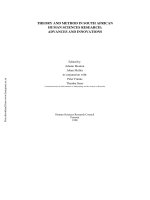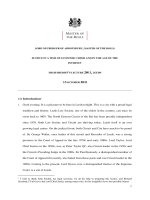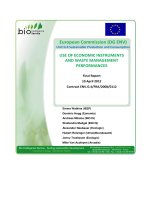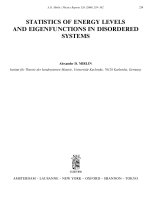Three applications of economic theory and methodology in information systems research
Bạn đang xem bản rút gọn của tài liệu. Xem và tải ngay bản đầy đủ của tài liệu tại đây (410.61 KB, 131 trang )
THREE APPLICATIONS OF ECONOMIC THEORY AND
METHODOLOGY IN INFORMATION SYSTEMS
RESEARCH
MENG, ZHAOLI
(M. A. Wu Han University, China
B.Sc. Xi’an Jiao Tong University, China)
A THESIS SUBMITTED
FOR THE DEGREE OF DOCTOR OF PHILOSOPHY
DEPARTMENT OF INFORMATION SYSTEMS
NATIONAL UNIVERSITY OF SINGAPORE
2005
i
ACKNOWLEDGEMENTS
I would like to express my gratitude to all those who gave me the possibility to complete
this thesis. First of all, I am deeply indebted to my two supervisors: Dr. Sang-Yong Tom
Lee and Dr. Ivan Png, for their insightful guidance, sustained support and generous help.
Four years ago, my oral English was so poor that I almost could not finish a complete
sentence. Dr. Lee accepted me as his student and helped me with all the patience. He
has spent much time and effort on teaching me how to be an independent researcher.
And, he has given me a lot of encouragement along the road. I still clearly remember that
I made a very bad presentation and almost lost all my confidence in my third year study.
Dr. Lee talked to me after the presentation and I heard one of the most beautiful words in
my life: “Trust me. You have the ability to get your Ph.D degree. I never doubt you can
do that.” His trust gave me the strength to move on. Without his support and
encouragement, I could not persist to today.
Dr Png is my idol (☺). He is the smartest and most capable man I had ever known. He
has taught me not only how to do research but also how to do things perfectly. I admire
his ability to make things simple and elegant. He is also a perfect manager, who knows
exactly how to help the subordinates to find and use their strong points. The only bad
thing to be his student is that it is almost impossible to find a better boss than him, which
ii
makes the graduation a pity. He has so many merits worth me learning from. One year’s
study under his guidance is too short and will be cherished in my heart.
I owe thanks to my two best friends in Singapore: Yin Yin Latt and Hu Yu. Yin Yin Latt
comes from Myanmar. It is precious that two girls from different countries with different
culture could be true sisters. All the shining days hanging around with them, all the
laughter and tears, are my best memory. I know they will guard me and hold my hands
whenever I need.
I am grateful to my friends here. They are Sun Jing, Wang Qiu Hong, Li Lin, Zhang
Cheng, Zhou You You, Guo Rui, Shi Shao Mei, Xia Chen Yi, Gao Jiong, and Guo Xin
Yu. Their friendship brings me a lot of joy.
I would like to express my heartfelt appreciation to Dr. Julian Wright for his effort to
maintain the IO workshop, which provides a platform for the researchers in economic and
IS fields to exchange ideas and discuss research questions together. I have met a lot of
excellent researchers there, such as Dr Lu, Jing Feng and Dr Candy Qian Tang. They
have given me a lot of encouragement and help for my research.
I thank Dr Laina Ho for her excellent lecture on English writing, where I learnt a lot of
skills about how to organize and write the Ph.D thesis. Also, I thank the Department of
Information Systems of NUS for giving me an opportunity to study in Singapore, as well
as the financial support.
iii
I give my deepest thanks to my families, especially to my parents, for their unconditional
love to me. My parents know how important education is because their generation did
not have the chance to attend University. They make all their efforts to support my
brothers and me to get high-level education. It is a very difficult thing in my lovely and
undeveloped hometown. In my four years of oversea study, I never encountered any
other student from the same province, which reminds me what a precious opportunity my
parents have given me. I know that they will feel happier than me to see this thesis.
Finally, this thesis is a gift to me. It represents my four-year effort, happiness, loneliness,
and success.
Meng, Zhaoli
December 2005
iv
TABLE OF CONTENTS
CHAPTER 1 Introduction 1
1.1. General Background 1
1.2. Three Studies 2
1.3. Contribution 7
References 10
CHAPTER 2 Open Source vs. Proprietary Software: Competition and Compatibility. 15
2.1. Introduction 15
2.2. Literature Review 19
2.3. Basic Model 21
2.4. Compatibility and Profits 24
2.5. Quality Differences 28
2.6. Best Compatibility Strategy 31
2.7. Welfare 35
2.8. Extension 38
2.9. Conclusions 43
References 46
Appendix 2.1. Best Compatibility Strategy 50
Appendix 2.2. Calculation of the Welfare 54
Appendix 2.3. Proof of Proposition 4 55
Appendix 2.4. Proof of Proposition 5 57
Appendix 2.5. Proof of Proposition 6 59
CHAPTER 3 The Value of IT to Firms in a Developing Country in the Catch-up
Process: an Empirical Comparison of China and the United States 61
3.1. Introduction 61
3.2. Hypotheses 63
3.3. Methodology 69
3.4. Data Collection 71
3.5. Results 73
3.6. Discussion 77
3.7. Conclusions 80
References 82
CHAPTER 4 Gallery Feature in eBay: Advertising or Signaling 91
v
4.1. Introduction 91
4.2. Theory 93
4.3. Hypotheses 95
4.4. Data 96
4.5. Results 99
4.6. Discussion and Conclusions 107
References 110
Appendix 4.1. Signaling Effect (Eviews) 113
CHAPTER 5 Conclusions and Future work 114
5.1. Competition between Open Source and Proprietary Software 114
5.2. IT Investment Value 116
5.3. Advertising and Signaling Behavior in eBay 117
5.4. Conclusions 120
References 121
vi
SUMMARY
Many problems in the field of IS can be solved using the theory and methodology of
economics. In this thesis, three IS research problems: competition and compatibility
between open source and proprietary software, IT investment value, advertising and
signaling in eBay, are investigated from an economic perspective.
The first study focuses on the compatibility choices of a proprietary software producer
when it competes with an open source software provider. By applying the Hotelling
linear city model, I find that the best compatibility strategy for the proprietary software
producer depends on the market coverage conditions. When the market is fully covered,
inward compatibility is the best strategy. On the other hand, when the market is not fully
covered, two-way compatibility is the best strategy. Such results are not affected by
software quality. Furthermore, the proprietary software producer does not favor a
proprietary rival changing to providing open source software, and such a change may
lower social welfare.
The second study uses the event study methodology of economics to examine whether IT
investments can pay off. A comparative study of IT investment value in China and the
U.S. investigates the differences in IT value between developing and developed countries.
The results clearly demonstrate that IT investments significantly increase the market
vii
value of firms in China while insignificantly in the U.S. This suggests that IT
investments have a more significant effect in developing rather than developed countries.
The third study aims to examine whether the optional features in eBay, such as Gallery,
are advertising tools or quality signals. Using field data, I find that auctions with Gallery
feature exhibited more intense competition, and thus had higher final auction price.
Therefore, the Gallery feature served as an advertising function. Moreover, for high-
priced products, high quality sellers were more likely to use the Gallery feature compared
with low quality sellers. Thus, the Gallery feature served as a quality signal, which
mitigated the information asymmetry between buyers and sellers.
These three studies demonstrate that economic theory and methodology can be used
effectively in IS research to address problems related to IT and its application in e-
commerce.
viii
LIST OF TABLES
Table 2.1: Fully Covered Market: Equilibrium Outcomes 26
Table 2.2: Partly Covered Market: Equilibrium Outcomes 27
Table 2.3: Quality Differences: Fully Covered Market 29
Table 2.4: Quality Differences: Partly Covered Market 30
Table 2A.1: Fully Covered Market: Competition Outcomes 55
Table 2A.2: Partly Covered Market: Competition Outcomes 56
Table 2A.3: The Comparison of Two Cases Where Two Products Are Incompatible 57
Table 2A.4: The Comparison of Two Cases Where Two Products Are Compatible 58
Table 3.1: Test Results: Overall Effect 73
Table 3.2: Test Results: Industry Effect 74
Table 3.3: Test Results: Firm Size Effect 75
Table 3.4: Test Results: Firm Type Effect 76
Table 3.5: Summary: Test Results of the Hypotheses 77
Table 4.1.1: Data Descriptions 97
Table 4.1.2: Data Descriptions 98
Table 4.2: Advertising Effect: Each Product Category 100
Table 4.3: Advertising Effect: Whole Sample 102
Table 4.4: Signaling Effect: Positive Ratio 104
Table 4.5: Signaling Effect: Feedback Score (Spss) 106
Table 4A.1: Signaling Effect: Feedback Score (Eviews) 113
ix
LIST OF FIGURES
Figure 2.1: Basic Hotelling Model 22
Figure 2.2: Competition: Partly Covered Market 26
Figure 2.3: Welfare when .05
γ
= and s0
=
37
Figure 2.4: Picture of
op pp
WW− 42
1
CHAPTER 1 INRODUCTION
1.1. General Background
This thesis applies economic theory and methodology in Information Systems (IS)
research to study issues associated with information technology (IT) and its application in
the electronic market. A basic definition of IS and its relationship with economics is
given in the following sections to explain why economic theory and methodology can be
usefully applied in the IS field.
The IS discipline has been defined in different ways. It has been depicted as “the study
of the interaction of development and use of IS with organizations” (Cushing 1990), and
“understanding what is or might be done with computer and software technical systems,
and the effects they have in the human, organizational and social world” (Avgerou and
Cornford 1995). Meanwhile, Davis et al. (1997) presented two areas which IS
investigates: “(1) acquisition, deployment, and management of information technology
resources and services (the information systems function), and (2) development and
evolution of infrastructure and systems for use in organization processes (system
development)”. In conclusion, IS discipline investigates: (i) the development and
application of IT, (ii) the relationship between the IT and social organization.
Economics has been widely accepted as not only one of the reference disciplines of IS
but also one of the main IS research themes. Ever since the first International Conference
of Information Systems (ICIS), economics has been deemed as one of the four reference
2
disciplines of IS together with computer science, management science and organization
science (Benbasat and Weber 1996). These four reference disciplines form the major
foundations of IS (Keen 1980). Moreover, many researchers classify economic
application in IS research as one of the main subjects of IS research (Culnan and
Swanson 1986, Culnan 1987, Swanson and Ramiller 1993, Gosain et al. 1997). Various
economic theories, such as game theory and economic models of organizational
performance, have been applied to explain, predict and solve IS problems.
The reasons for the wide application of economics in IS field are: (i) IS and economics
have an affinitive relationship, (ii) the economics discipline has solid theory foundation
and mature methodology, which could be used as effective tools by IS researchers, (iii)
economics addresses new problems arising with the growth of Internet Commerce.
The three essays in this thesis apply economic theory and methodology to solve three
research problems in the field of IS, which are competition and compatibility between
open source software and proprietary software, IT investment value, advertising and
signaling in eBay.
1.2. Three Studies
1.2.1. Competition and Compatibility with Open Source Software
The first essay applies the Hotelling model of horizontal product differentiation to
investigate competition between open source software and proprietary software. Open
source software allows software developers to use shared source codes, identify and
3
correct errors, and redistribute the source codes (OSI 2001, O’Reilly 1999). Open source
software has won striking success in recent years and become a threat to proprietary
software. Typical examples include Linux vs. Windows and Apache vs. Microsoft IIS.
Facing open source competitors, the developers of the proprietary software intentionally
chose different compatibility strategies in different cases.
1
For instance, Microsoft
intentionally made its website incompatible with Firefox, the new open source web
browser. However, concerning web server software, Microsoft chose to be inward
compatible with the open source software.
2
For example, in the web server market,
Microsoft IIS (the proprietary web server) can support both PHP and ASP, the server side
programming language. Thus, the programs designed for Apache (the open source web
server) using PHP language can be run in IIS. However, since ASP belongs to Microsoft
and cannot run on Apache, the programs designed for IIS using ASP are not fully usable
in Apache.
In competition between two products with separate networks, if the network effects are
strong enough, the respective producers face a dilemma regarding the choice of the
compatibility. By choosing to be compatible, its users benefit from the network of the
rival, but this increases competition. On the other hand, by choosing to be incompatible,
1
Katz and Shapiro (1998) defined compatible as “when two programs can communicate with one
another and/or be used with same complementary system components, they are said to be compatible”.
2
For the proprietary software, inward compatibility means that the files or programs designed for the
open source software product can be used by the proprietary software, but the files or programs
designed for the proprietary software may not be fully usable in the open source software product.
4
the producer may reduce the intensity of the competition, but then prevents sharing of the
network from the competitor.
Which compatibility strategy should be chosen? What is the profit for the proprietary
software producer under each compatibility strategy? Will the profit of a proprietary
software producer increase or fall when its rival changes from providing proprietary to
open source software? What are the welfare implications? Such research questions are
interesting to both researchers and industry practitioners.
Although the competition and compatibility of two products with different networks have
been well explored in the economic and IS fields (Katz and Shapiro 1985, 1986, 1994;
Conner 1995), their results may not be applicable in the case of open source software vs.
proprietary software. The reason is that the open source software is free and its profit is
zero. Therefore, its competition with proprietary software is obviously different from the
traditional duopoly competition where two parties pursue maximum profit.
Concerning such differences, I have built a Hotelling linear city model to study
competition between open source and proprietary software, where only the proprietary
software producer aims at maximizing the profit and the open source software reacts
passively. The best compatibility strategy of the proprietary software producer is
investigated in two cases - where the market is fully covered and where the market is not
fully covered. It is found that the best compatibility strategy under these two cases is
different. Furthermore, it is proved that the proprietary software producer does not favor
5
its proprietary rival changes to open source software. Such change may reduce social
welfare.
1.2.2. IT Investment Value
Past decades have witnessed substantial increases in IT investments. However, despite
the heavy investments in IT, there has been little evidence of the value produced by IT in
aggregate output statistics. Nobel laureate Robert Solow (1987) concluded that “you can
see the computer age everywhere but in the productivity statistics”. This widely known
“productivity paradox” has engendered many amounts of studies including research at the
country-level (Baily 1986, Jorgenson and Stiroh 2000), industry-level (Schneider 1987,
Roach 1987, 1991), and firm-level (Harris and Katz 1991). However, the results of these
studies were inconclusive.
Given the equivocal results of the productivity approach, researchers have investigated IT
value from other angles. One of these angles is to examine how IT improves firm
performance. In particular, IT value could be proved as the increase of the firms’ market
value. The innovative research in this theme is by Dos Santos et al. (1993) and Im et al.
(2001). They used the event study methodology to provide evidence that IT investments
can increase the market value of firms. Both of them, however, got negative results.
Most previous studies of IT value were limited to U.S. data. However, with the rise of
Asia in recent years, the value of IT in Asia has attracted much attention (Amsden 2001,
Enos et al. 1997, Hobday 1995, Kim 1997, Lall 2000, Mathews and Cho 2000).
6
Some scholars believe that IT plays an important role in the rise of Asian firms. In
contrast, other researchers are skeptical about the efficiency of IT adoption and diffusion
in developing countries. Compared with developed countries, developing countries are
believed to have inadequate IT infrastructures, ineffective policy and lack of
communication (Sauvant 1984, Dasgupta et al. 1999, Dewan and Kraemer 2000). All
these obstacles could slow down IT adoption in developing countries. As a result, IT
investment in the firms in developing countries may not be as efficient as that in
developed countries.
Because of these contradictive expectations, I conducted a comparative study of IT
investment value to firms in developing countries vis-à-vis developed countries, to
provide a better understanding of IT value in different contexts. This study tries to
answer the following questions: (1) Whether IT can increase the firms’ value in
developing countries and developed countries respectively; (2) Whether IT investment in
firms in developing countries is as efficient as that in developed countries; (3) How does
IT value vary with respect to various features such as the firm size and firm type in
different countries?
1.2.3. Advertising and Signaling in eBay
The third essay aims to study advertising and signaling effects in online auction markets.
Major online auction markets, such as eBay and Yahoo auction, provide optional features,
such as Gallery (inserting a large picture of the items being sold), for sellers to promote
7
their items. The research question arises: What is the function of these optional features?
One possibility is that these features are advertising which attracts buyers’ attention and
increases sellers’ profit. Another possibility is that these features could be quality signals,
which mitigate the information asymmetry between buyers and sellers.
To distinguish between the advertising and the signaling effects, I collected field data
from eBay to test the sales-response function and sellers’ selection of the Gallery feature.
It was found that auctions with the Gallery feature exhibit more intense competition and
end with a higher price. Such results indicate that the Gallery feature serves as an
advertising tool. Moreover, for high-priced products, high quality sellers are more likely
to choose the Gallery feature than low quality sellers. Hence, for high-priced products,
Gallery is a quality signal, which helps sellers credibly communicate the private
information and establish trust with buyers.
This study has two empirical implications: firstly, these optional features are proved to be
profitable advertising tools. Hence, sellers can use them to earn price premia. Secondly,
for high-priced products, these optional features may help buyers to get more information
about sellers’ quality and reduce the risk in online transactions.
1.3. Contribution
More and more proprietary software producers must compete with open source software.
However, there have been few studies of the compatibility choices of proprietary
software producers. The first essay in this thesis addresses this issue and provides
8
theoretical support for the managers of the proprietary software regarding the
compatibility strategies. Furthermore, the results shed light on the impact of the open
source software on the proprietary software producer and on society. Moreover, the
welfare analysis suggests to governments that the move to open source software may
lower social welfare. Thus, the governments should be careful to promote the open
source movement.
How to measure the value of IT has been discussed for decades in the field of IS. Most
research in this field was limited to U.S. data. Moreover, previous studies could not find
positive evidence that IT investments can increase the market value of the firms. The
second essay in this thesis provides a comparative study of IT investment value in China
with that in the U.S. It showed that IT investments have a positive impact on the firms in
China, but not in the U.S. Thus, IT could be a bigger opportunity for the firms in
developing countries compared with those in developed countries. This essay provides
empirical evidence for the IT value in developing counties, and hence enriches the
limited research in this stream.
Signaling has a solid theoretical foundation, but limited empirical support. In the third
essay in this thesis, I conduct an empirical test, which examines whether the optional
features used in eBay are quality signals or advertising tools. Such a test provides
empirical support for the signaling theory. Furthermore, the Gallery feature is proved to
serve advertising and signaling functions, which can smooth transactions and establish
9
trust between transaction parties. E-commerce providers can apply these findings in their
service design.
This thesis is organized as follows: Chapter 2 presents the essay “Open Source vs.
Proprietary Software: Competition and Compatibility”; Chapter 3 presents “The Value of
IT to Firms in a Developing Country in the Catch-up Process: an Empirical Comparison
of China and the Untied States”; while Chapter 4 presents the essay “Gallery Feature in
eBay: Advertising or Signaling”. In the last chapter, I briefly summarize the results of
these three essays and propose a few possible directions for future research.
10
References
Akerlof, G. 1970. The market for “lemons”: Quality under uncertainty and the market
mechanism. Quarterly Journal of Economics, 84, 488-500.
Amsden, A. 1989. Asia’s Next Giant: South Korea and Late Industrialization. NY:
Oxford University Press.
Avgerou, C., Cornford, T. 1995. Limitations of information systems theory and practice:
A case for pluralism. in Falkenberg et al., Information Systems Concepts: Towards
a Consolidation of Views, London: ChapmanandHall, 130-143.
Baily, M. N. 1986. What has happened to productivity growth?. Science, 234 (4775),
443-451.
Benbasat, I., Weber, R. 1996. Research commentary: rethinking ‘Diversity’. Information
Systems Research, 7(4), 389-399.
Boulding, W., Kirmani, A. 1993. A Consumer-Side Experimental Examination of
Signaling Theory: Do Consumers Perceive Warranties as Signals of Quality. The
Journal of Consumer Research, 20(1), 111-123.
Conner, K. 1995. Obtaining Strategic Advantage from Being Imitated: When Can
Encouraging ‘Clones’ Pay?. Management Science, 42(2).
Culnan, M. 1987. Mapping the Intellectual Structure of MIS, 1980-85: A Co-Citation
Analysis. Management Information Systems Quarterly, 11(3), 340-353.
11
Culnan, M., Swanson, E.B. 1986. Research in management information systems 1980-
1984: Points of work and reference. Management Information Systems Quarterly,
10(3), 289-301.
Cushing, B.E. 1990. Frameworks, Paradigms, and Scientific Research in Management
Information Systems. The Journal of Information Systems, 4(2), 38-59.
Dasgupta, S., Agarwal, D., Ioannidis, A., Gopalakrishnan, S., 1999. Determinants of
Information Technology Adoption: An Extension of Existing Models to Firms in a
Developing Country. Journal of Global Information Management, 7(3), 41-49.
Davis, G.B., Gorgone, J.T., Couger, J.D., Feinstein, D.L, Longnecker, Jr., H.E. 1997.
IS’97: Model Curriculum and Guidelines for Undergraduate Degree programs in
Information Systems. The DATA- BASE for Advances in Information Systems,
Vol.28, No. 1, Winter.
Dewan, S., Kraemer, K. L., 2000. Information technology and productivity: Evidence
from country-level data. Management Science, 46(4), 548-562.
Dos Santos, B.L., Peffers, K., Mauer, D.C. 1993. The impact of information technology
investment announcements on the market value of the firm. Information Systems
Research, 4(1), 1-23.
Enos, J., Lall, S., Yun, M., 1997. Transfer of technology: An update. Asian-Pacific
Economic Literature, 11 (1), 56-66.
Gosain, S., Lee, Z., Im, L. 1997. Topics of interest in IS: Comparing academic journals
with the practitioner press. Proceedings of the International Conference on
Information Systems, Atlanta, Georgia, December 15-17, 263-284.
12
Harris, S. E., Katz, J.L. 1991. Firm Size and the Information Technology Investment
Intensity of Life Insurers. MIS Quarterly, 15(3), 333-352.
Hobday, M. 1995. Innovation in East Asia: The Challenge to Japan. Aldershot, UK:
Edward Elgar.
Im K.S., Dow, K.E., Grover, V. 2001. A reexamination of IT investments and the market
value of the firm: an event study methodology. Information Systems Research,
12(1), 103-117.
Jorgenson, D. W., Stiroh, K. J. 2000. Raising the speed limit: U. S. economic growth in
the information age. Brookings Papers on Economic Activity, 1, 125-235.
Katz, M., Shapiro, C. 1985. Network externalities, competition and compatibility.
American Economic Review. 75(3) 424-440.
Katz, M., Shapiro, C. 1986, Technology Adoption in the Presence of Network
Externalities. Journal of Political Economy, 94, pp. 822-841.
Katz, M., Shapiro, C. 1994. Systems Competition and Network Effects. Journal of
Economic Perspectives, 8(2).
Keen, P. G. W. 1980. MIS research: Reference disciplines and cumulative tradition. in
Proceedings of the First international Conference on Information Systems, E. R.
McLean (ed.), Philadelphia, 9-17.
Kim, L., 1997. Imitation to Innovation: The Dynamics of Korea’s Technological
Learning. Boston: Harvard Business School Press.
Lall, S., 2000. Technological change and industrialization in the Asian newly
industrializing economies: Achievements and challenges. In L. Kim, and R.R.
13
Nelson, Technology, Learning, and Innovation: Experiences of Newly
Industrializing Economies. Cambridge, UK: Cambridge University Press.
Mathews, J. A., Cho, D. S. 2000. Tiger Technology: The Creation of a Semiconductor
Industry in East Asia. Cambridge, UK: Cambridge University Press.
Milgrom, P., Roberts, J. 1982. Limit Pricing and Entry under Incomplete Information: An
Equilibrium Analysis. Econometrica, 50(2), 443-460.
Nelson, P. 1970. Information and Consumer Behavior. The Journal of Political Economy.
78(2), 311-329.
O’Reilly, T. 1999. Lessons from open-source software development. Communications of
the ACM. 42(4) 33-37.
OSI. 2001. The Open Source Definition.
Roach, S. S. 1987. America's Technology Dilemma: A profile of the information
economy. Morgan Stanley Special Economic Study. April.
Roach, S. S. 1991. Services under siege: the restructuring imperative. Harvard Business
Review, 60(5), 82-92.
Sauvant, K.P. 1984. The growing dependence on transborter Data Flows. Computerworld,
18(26).
Schneider, K. 1987. Services hurt by technology: productivity is declining. The New York
Times, June 29.
Solow, R. M. 1987. We’d better watch out. New York Times Book Review. July 12.
14
Spence, M. 1973. Job marketing Signaling. The Quarterly Journal of Economics, 87(3),
355-374.
Swanson, E.W., Ramiller, N.C. 1993. Information systems research thematic:
submissions to a new journal, 1987-1992. Information Systems Research, 4(4), 299-
358.
Wolinsky, A. 1983. Prices as Signals of Product Quality. The Review of Economics
Studies, 50(4), 647-658.
15
CHAPTER 2 OPEN SOURCE VS. PROPRIETARY
SOFTWARE: COMPETITION AND COMPATIBILITY
2.1. Introduction
Recent years have seen the striking success of open source software, which allows
software developers to use shared source codes, identify and correct errors, and
redistribute the source codes (OSI 2001, O’Reilly 1999). One of the most famous and
successful open source software projects is Linux, which commands a third market share
within the server operating system market, and whose share is expected to grow to 41
percent by 2005 (International Data Corporation IDC 2002). Another well-known
example is Apache, which supports 67 percent of web sites on the Internet (Netcraft Web
Server Survey 2004). Other successful open source software products have had
significant market shares in their product categories. For instance, Sendmail, an open
source email transfer program, carries an estimated 80% of the entire world’s e-mail
traffic (Weber 2004).
Open source software threatens proprietary software producers.
3
Amazon reported that
adopting open source software has reduced 25 percent of its technology expenses. The
European city Munich is switching from Windows to Linux, and from Internet Explorer
(IE) to Mozilla browser (CNet News 2004a).
3
I use the term ‘proprietary software’ as non-free software (Working Group on Libre Software 2000).









